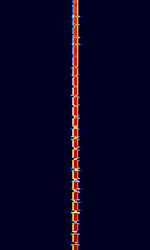Sonne
Sonne (Called Consol by the Britons) was a low-frequency radio range based radio navigation system used for long range navigation. The system was derived from the United States based Elektra system, and was developed by the Germans during WWII. The theoretical accuracy was 0.6 degrees of arc, or 3 miles at 1000 miles. The system proved so simple and effective that it was implemented all over Europe and even into the US until the early 90's when newer systems like LORAN-C and GPS became more affordable.
Operation[edit]
Sonne used a beam consisting of two regions, one of morse dots and the other dashes that overlapped so that in the centre, a continuous signal was heard. The beam was transmitted from 3 fixed masts but electronically rotated so that a full cycle took about 30 sec. In between cycles, the station ID was transmitted in morse from the centre antenna only, i.e. omnidirectionally. The navigator's bearing was given by counting the dashes until they merged into the equisignal region.
Sonne keyed the signal once per second, allowing the timing to be captured simply by counting the number of dots or dashes. To make this process even easier, a series of nautical charts were produced with the counts listed on them. The navigator simply looked up the number on the chart to reveal the bearing.
Sample[edit]
The audio sample is a simulation of LEC at Stavanger, Norway which remained operational on 319kHz until 1991. Sample source Alan Cordwell.
